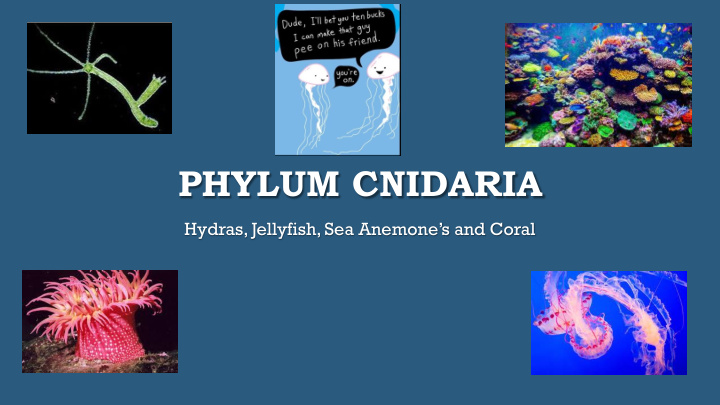



PHYLUM CNIDARIA Hydras, Jellyfish, Sea Anemone’s and Coral
FEATURES OF CNIDARIANS • Cnidarians are soft-bodied • Carnivorous animals • Stinging tentacles arranged in circles around their mouths • They are the simplest animals to have body symmetry • Specialized tissues
STRUCTURE AND FUNCTION • Cnidarians get their name from the cnidocytes • Stinging cells, located along their tentacles • Used for defense and to capture prey • Within each cnidocyte is a nematocyst • a poison-filled, stinging structure that contains a tightly coiled dart • When prey brush against the tentacles of a cnidarian, thousands of nematocysts explode into the animal • Paralyze/kill prey
Jellyfish sting
BODY PLAN • Radial Symmetry • Central mouth surrounded by tentacles
LIFE CYCLE • Cnidarians typically have a life cycle that includes two different-looking stages: a polyp and a medusa. • • Polyp • Cylindrical body with armlike tentacles • Mouth points upward • Sessile • Medusa • Motile • Bell shaped body • Mouth at bottom
2 LAYERS • The gastroderm is the inner lining of the gastrovascular cavity, where digestion takes place • Epidermis • Outer layer of cells (blue) • Mesoglea • Seperates epidermis and gastroderm
FEEDING • After stunning prey • Pulled into gastrovascular cavity using tentacles • Food and wastes leave the body through the same opening • Incomplete gut/digestive system • Digestion begins in the Gastrovascular cavity (GV) • Extracellular (outside cells) • Partially digested food absorbed by gastroderm Digestion completed intracellularly • Examples of feeding • Sea anemone • • Sea anenome Jellyfish •
RESPIRATION/CIRCULATION/EXCRETION • Only a few cells thick • Simple body system • Following digestion • Nutrients transported via diffusion • Respiration/excretion • Wastes leave via Diffusion through body walls
RESPONSE • Gather info via specialized sensory cells • Both polyps and medusas have a nerve net • loosely organized network of nerve cells • Allow cnidarians to detect stimuli • Statocysts • Group of sensory cells that help cnidarians determine the direction of gravity • Ocelli • Eyespots made of cells that detect light
Recommend
More recommend